ACR211: Crime Prevention and Security Literature Review - 2020
VerifiedAdded on 2022/08/24
|6
|1391
|16
Literature Review
AI Summary
This literature review explores the impact of technology on education, focusing on online learning and its implications for crime prevention. It examines the potential of technology to enhance education, reduce costs, and increase accessibility, while also addressing the challenges and risks associated with online coursework. The review highlights the disparities in educational success across socioeconomic groups, the underperformance of students in online courses compared to traditional classrooms, and the need for effective online teaching strategies. It also discusses the development of offline e-learning platforms to bridge the digital divide, the importance of mitigating risks such as privacy loss and psychological harms, and the role of institutions and parents in providing resources and knowledge to students. The review references key studies and research, providing insights into the evolving landscape of education and the critical need for effective crime prevention strategies in the digital age.
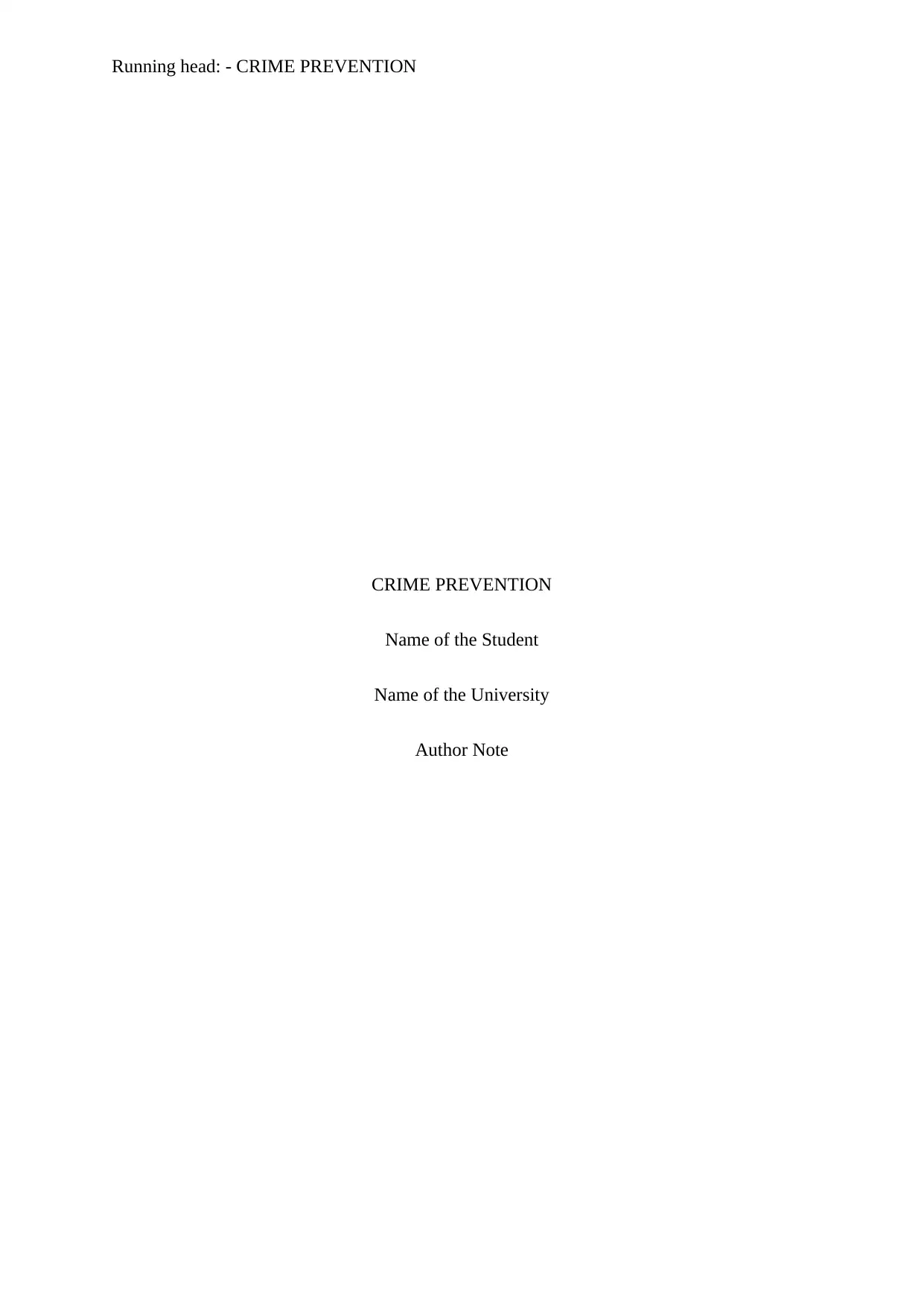
Running head: - CRIME PREVENTION
CRIME PREVENTION
Name of the Student
Name of the University
Author Note
CRIME PREVENTION
Name of the Student
Name of the University
Author Note
Paraphrase This Document
Need a fresh take? Get an instant paraphrase of this document with our AI Paraphraser

1CRIME PREVENTION
Table of Contents
Literature review........................................................................................................................2
References..................................................................................................................................5
Table of Contents
Literature review........................................................................................................................2
References..................................................................................................................................5
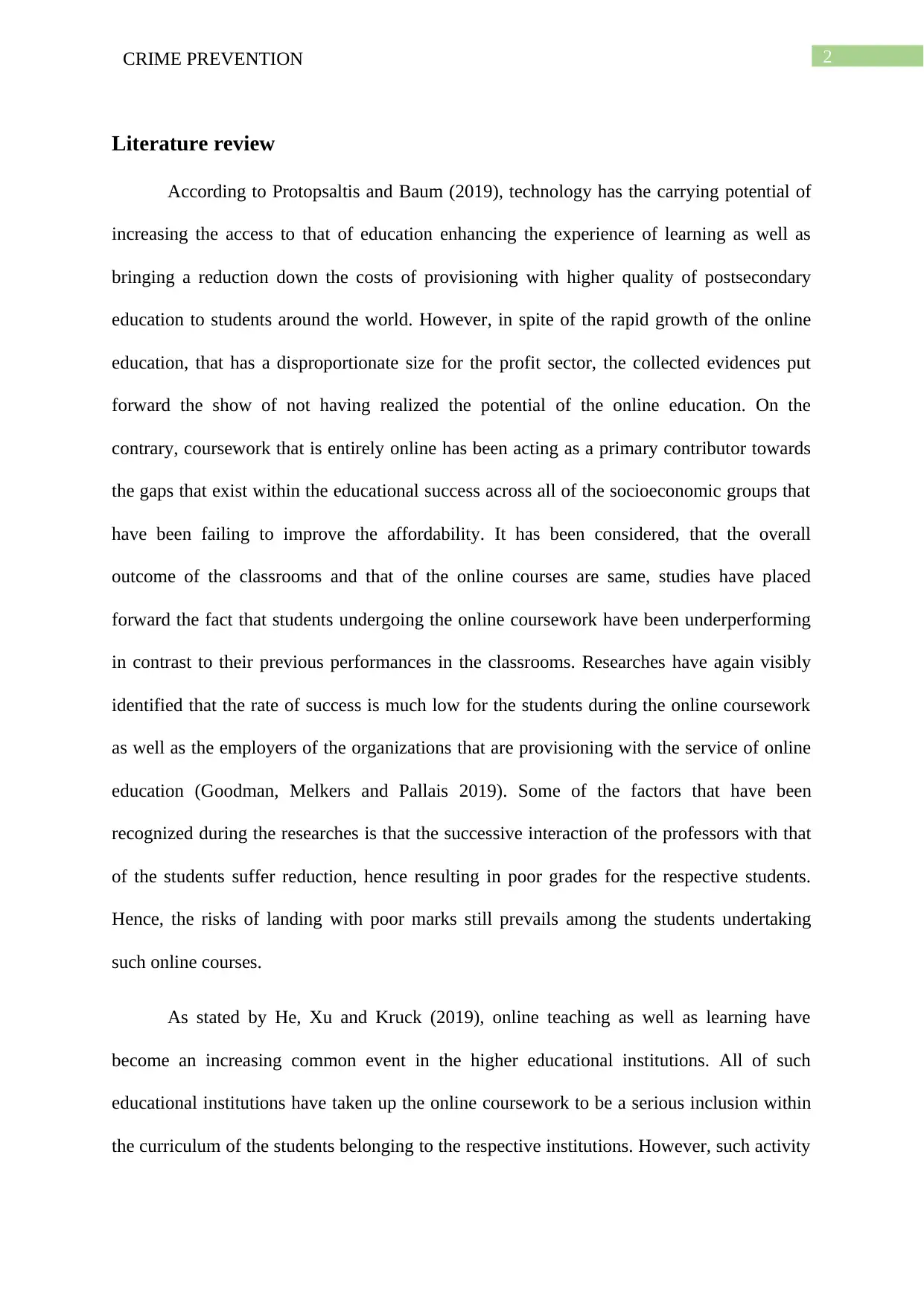
2CRIME PREVENTION
Literature review
According to Protopsaltis and Baum (2019), technology has the carrying potential of
increasing the access to that of education enhancing the experience of learning as well as
bringing a reduction down the costs of provisioning with higher quality of postsecondary
education to students around the world. However, in spite of the rapid growth of the online
education, that has a disproportionate size for the profit sector, the collected evidences put
forward the show of not having realized the potential of the online education. On the
contrary, coursework that is entirely online has been acting as a primary contributor towards
the gaps that exist within the educational success across all of the socioeconomic groups that
have been failing to improve the affordability. It has been considered, that the overall
outcome of the classrooms and that of the online courses are same, studies have placed
forward the fact that students undergoing the online coursework have been underperforming
in contrast to their previous performances in the classrooms. Researches have again visibly
identified that the rate of success is much low for the students during the online coursework
as well as the employers of the organizations that are provisioning with the service of online
education (Goodman, Melkers and Pallais 2019). Some of the factors that have been
recognized during the researches is that the successive interaction of the professors with that
of the students suffer reduction, hence resulting in poor grades for the respective students.
Hence, the risks of landing with poor marks still prevails among the students undertaking
such online courses.
As stated by He, Xu and Kruck (2019), online teaching as well as learning have
become an increasing common event in the higher educational institutions. All of such
educational institutions have taken up the online coursework to be a serious inclusion within
the curriculum of the students belonging to the respective institutions. However, such activity
Literature review
According to Protopsaltis and Baum (2019), technology has the carrying potential of
increasing the access to that of education enhancing the experience of learning as well as
bringing a reduction down the costs of provisioning with higher quality of postsecondary
education to students around the world. However, in spite of the rapid growth of the online
education, that has a disproportionate size for the profit sector, the collected evidences put
forward the show of not having realized the potential of the online education. On the
contrary, coursework that is entirely online has been acting as a primary contributor towards
the gaps that exist within the educational success across all of the socioeconomic groups that
have been failing to improve the affordability. It has been considered, that the overall
outcome of the classrooms and that of the online courses are same, studies have placed
forward the fact that students undergoing the online coursework have been underperforming
in contrast to their previous performances in the classrooms. Researches have again visibly
identified that the rate of success is much low for the students during the online coursework
as well as the employers of the organizations that are provisioning with the service of online
education (Goodman, Melkers and Pallais 2019). Some of the factors that have been
recognized during the researches is that the successive interaction of the professors with that
of the students suffer reduction, hence resulting in poor grades for the respective students.
Hence, the risks of landing with poor marks still prevails among the students undertaking
such online courses.
As stated by He, Xu and Kruck (2019), online teaching as well as learning have
become an increasing common event in the higher educational institutions. All of such
educational institutions have taken up the online coursework to be a serious inclusion within
the curriculum of the students belonging to the respective institutions. However, such activity
⊘ This is a preview!⊘
Do you want full access?
Subscribe today to unlock all pages.

Trusted by 1+ million students worldwide
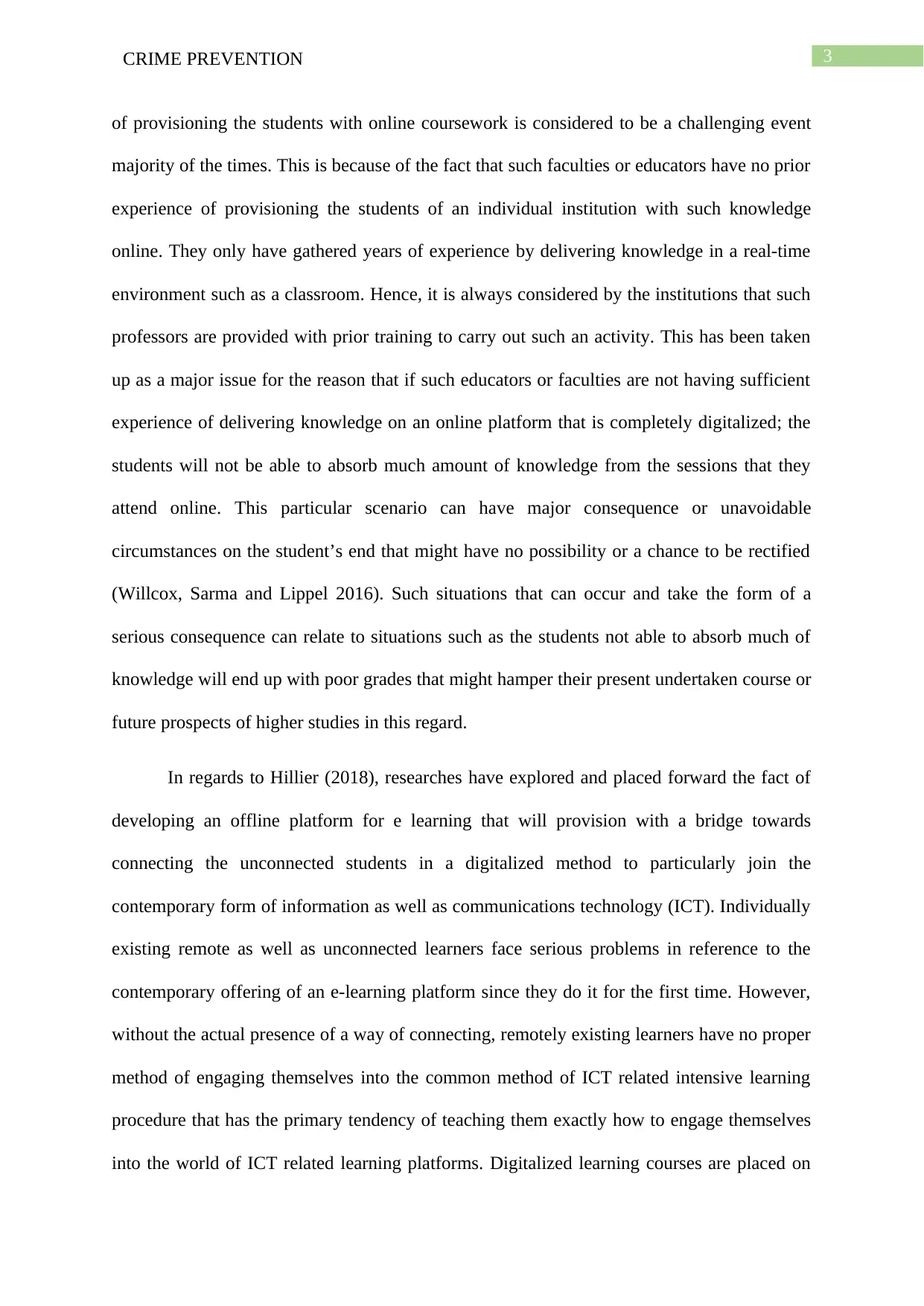
3CRIME PREVENTION
of provisioning the students with online coursework is considered to be a challenging event
majority of the times. This is because of the fact that such faculties or educators have no prior
experience of provisioning the students of an individual institution with such knowledge
online. They only have gathered years of experience by delivering knowledge in a real-time
environment such as a classroom. Hence, it is always considered by the institutions that such
professors are provided with prior training to carry out such an activity. This has been taken
up as a major issue for the reason that if such educators or faculties are not having sufficient
experience of delivering knowledge on an online platform that is completely digitalized; the
students will not be able to absorb much amount of knowledge from the sessions that they
attend online. This particular scenario can have major consequence or unavoidable
circumstances on the student’s end that might have no possibility or a chance to be rectified
(Willcox, Sarma and Lippel 2016). Such situations that can occur and take the form of a
serious consequence can relate to situations such as the students not able to absorb much of
knowledge will end up with poor grades that might hamper their present undertaken course or
future prospects of higher studies in this regard.
In regards to Hillier (2018), researches have explored and placed forward the fact of
developing an offline platform for e learning that will provision with a bridge towards
connecting the unconnected students in a digitalized method to particularly join the
contemporary form of information as well as communications technology (ICT). Individually
existing remote as well as unconnected learners face serious problems in reference to the
contemporary offering of an e-learning platform since they do it for the first time. However,
without the actual presence of a way of connecting, remotely existing learners have no proper
method of engaging themselves into the common method of ICT related intensive learning
procedure that has the primary tendency of teaching them exactly how to engage themselves
into the world of ICT related learning platforms. Digitalized learning courses are placed on
of provisioning the students with online coursework is considered to be a challenging event
majority of the times. This is because of the fact that such faculties or educators have no prior
experience of provisioning the students of an individual institution with such knowledge
online. They only have gathered years of experience by delivering knowledge in a real-time
environment such as a classroom. Hence, it is always considered by the institutions that such
professors are provided with prior training to carry out such an activity. This has been taken
up as a major issue for the reason that if such educators or faculties are not having sufficient
experience of delivering knowledge on an online platform that is completely digitalized; the
students will not be able to absorb much amount of knowledge from the sessions that they
attend online. This particular scenario can have major consequence or unavoidable
circumstances on the student’s end that might have no possibility or a chance to be rectified
(Willcox, Sarma and Lippel 2016). Such situations that can occur and take the form of a
serious consequence can relate to situations such as the students not able to absorb much of
knowledge will end up with poor grades that might hamper their present undertaken course or
future prospects of higher studies in this regard.
In regards to Hillier (2018), researches have explored and placed forward the fact of
developing an offline platform for e learning that will provision with a bridge towards
connecting the unconnected students in a digitalized method to particularly join the
contemporary form of information as well as communications technology (ICT). Individually
existing remote as well as unconnected learners face serious problems in reference to the
contemporary offering of an e-learning platform since they do it for the first time. However,
without the actual presence of a way of connecting, remotely existing learners have no proper
method of engaging themselves into the common method of ICT related intensive learning
procedure that has the primary tendency of teaching them exactly how to engage themselves
into the world of ICT related learning platforms. Digitalized learning courses are placed on
Paraphrase This Document
Need a fresh take? Get an instant paraphrase of this document with our AI Paraphraser
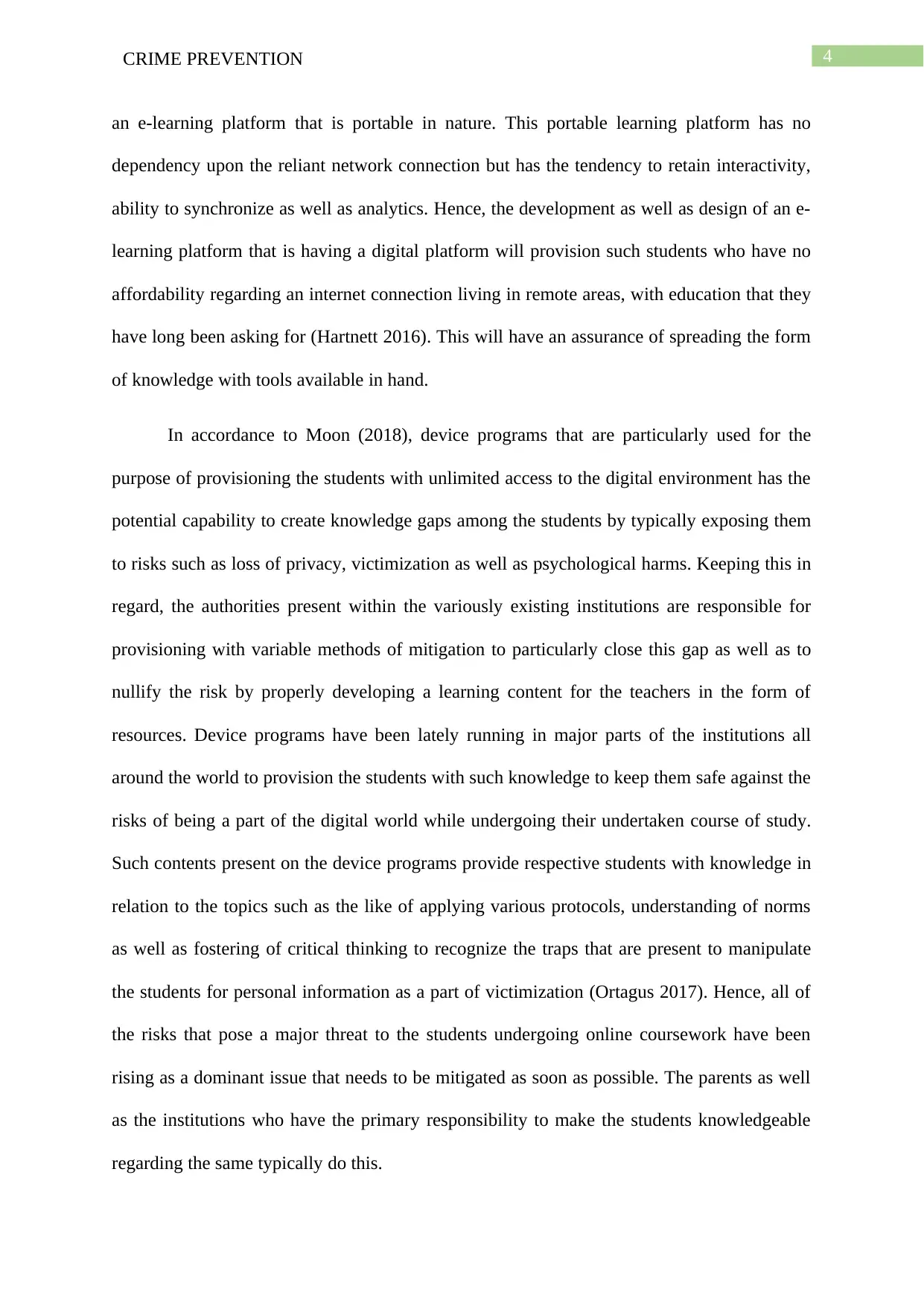
4CRIME PREVENTION
an e-learning platform that is portable in nature. This portable learning platform has no
dependency upon the reliant network connection but has the tendency to retain interactivity,
ability to synchronize as well as analytics. Hence, the development as well as design of an e-
learning platform that is having a digital platform will provision such students who have no
affordability regarding an internet connection living in remote areas, with education that they
have long been asking for (Hartnett 2016). This will have an assurance of spreading the form
of knowledge with tools available in hand.
In accordance to Moon (2018), device programs that are particularly used for the
purpose of provisioning the students with unlimited access to the digital environment has the
potential capability to create knowledge gaps among the students by typically exposing them
to risks such as loss of privacy, victimization as well as psychological harms. Keeping this in
regard, the authorities present within the variously existing institutions are responsible for
provisioning with variable methods of mitigation to particularly close this gap as well as to
nullify the risk by properly developing a learning content for the teachers in the form of
resources. Device programs have been lately running in major parts of the institutions all
around the world to provision the students with such knowledge to keep them safe against the
risks of being a part of the digital world while undergoing their undertaken course of study.
Such contents present on the device programs provide respective students with knowledge in
relation to the topics such as the like of applying various protocols, understanding of norms
as well as fostering of critical thinking to recognize the traps that are present to manipulate
the students for personal information as a part of victimization (Ortagus 2017). Hence, all of
the risks that pose a major threat to the students undergoing online coursework have been
rising as a dominant issue that needs to be mitigated as soon as possible. The parents as well
as the institutions who have the primary responsibility to make the students knowledgeable
regarding the same typically do this.
an e-learning platform that is portable in nature. This portable learning platform has no
dependency upon the reliant network connection but has the tendency to retain interactivity,
ability to synchronize as well as analytics. Hence, the development as well as design of an e-
learning platform that is having a digital platform will provision such students who have no
affordability regarding an internet connection living in remote areas, with education that they
have long been asking for (Hartnett 2016). This will have an assurance of spreading the form
of knowledge with tools available in hand.
In accordance to Moon (2018), device programs that are particularly used for the
purpose of provisioning the students with unlimited access to the digital environment has the
potential capability to create knowledge gaps among the students by typically exposing them
to risks such as loss of privacy, victimization as well as psychological harms. Keeping this in
regard, the authorities present within the variously existing institutions are responsible for
provisioning with variable methods of mitigation to particularly close this gap as well as to
nullify the risk by properly developing a learning content for the teachers in the form of
resources. Device programs have been lately running in major parts of the institutions all
around the world to provision the students with such knowledge to keep them safe against the
risks of being a part of the digital world while undergoing their undertaken course of study.
Such contents present on the device programs provide respective students with knowledge in
relation to the topics such as the like of applying various protocols, understanding of norms
as well as fostering of critical thinking to recognize the traps that are present to manipulate
the students for personal information as a part of victimization (Ortagus 2017). Hence, all of
the risks that pose a major threat to the students undergoing online coursework have been
rising as a dominant issue that needs to be mitigated as soon as possible. The parents as well
as the institutions who have the primary responsibility to make the students knowledgeable
regarding the same typically do this.
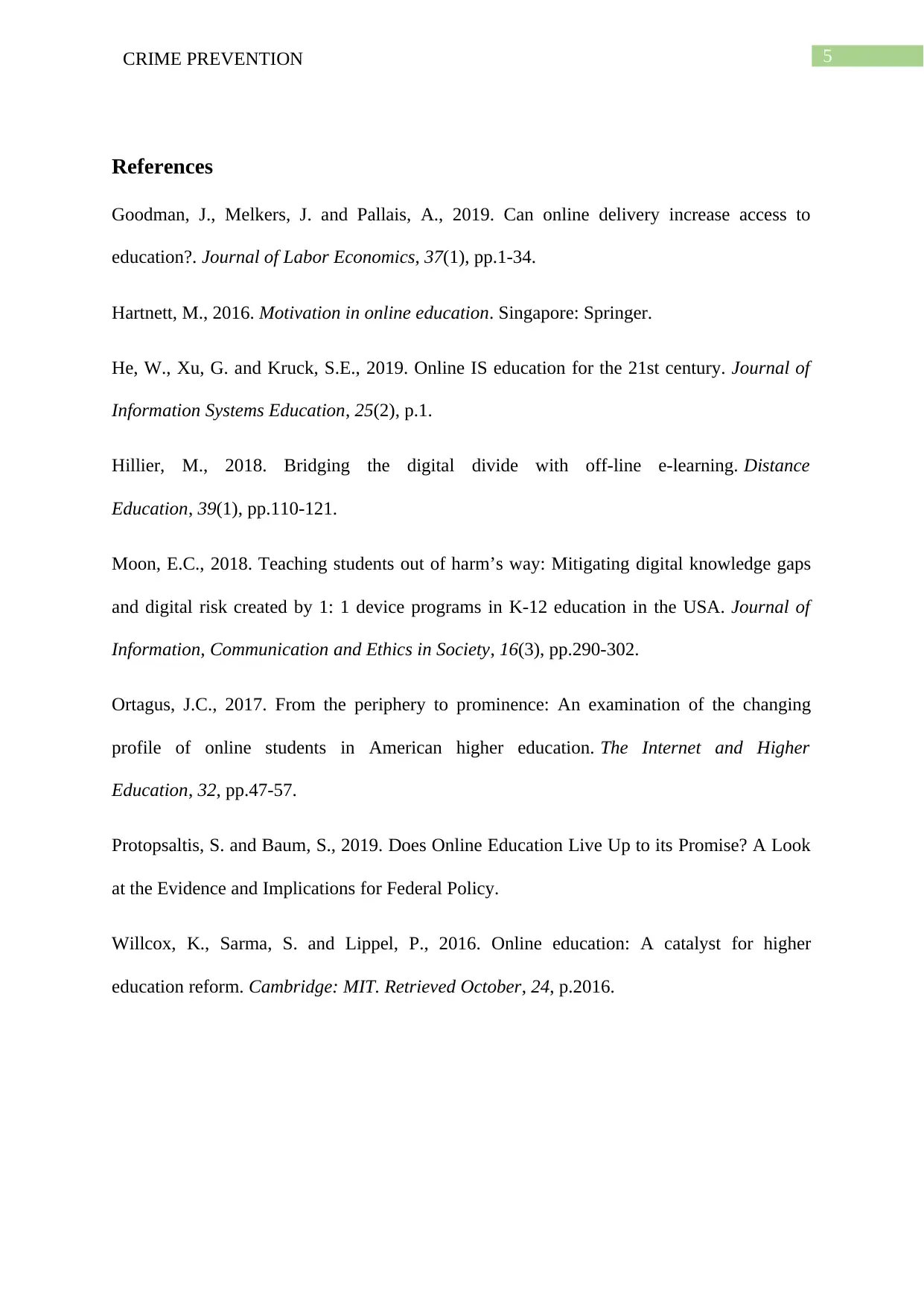
5CRIME PREVENTION
References
Goodman, J., Melkers, J. and Pallais, A., 2019. Can online delivery increase access to
education?. Journal of Labor Economics, 37(1), pp.1-34.
Hartnett, M., 2016. Motivation in online education. Singapore: Springer.
He, W., Xu, G. and Kruck, S.E., 2019. Online IS education for the 21st century. Journal of
Information Systems Education, 25(2), p.1.
Hillier, M., 2018. Bridging the digital divide with off-line e-learning. Distance
Education, 39(1), pp.110-121.
Moon, E.C., 2018. Teaching students out of harm’s way: Mitigating digital knowledge gaps
and digital risk created by 1: 1 device programs in K-12 education in the USA. Journal of
Information, Communication and Ethics in Society, 16(3), pp.290-302.
Ortagus, J.C., 2017. From the periphery to prominence: An examination of the changing
profile of online students in American higher education. The Internet and Higher
Education, 32, pp.47-57.
Protopsaltis, S. and Baum, S., 2019. Does Online Education Live Up to its Promise? A Look
at the Evidence and Implications for Federal Policy.
Willcox, K., Sarma, S. and Lippel, P., 2016. Online education: A catalyst for higher
education reform. Cambridge: MIT. Retrieved October, 24, p.2016.
References
Goodman, J., Melkers, J. and Pallais, A., 2019. Can online delivery increase access to
education?. Journal of Labor Economics, 37(1), pp.1-34.
Hartnett, M., 2016. Motivation in online education. Singapore: Springer.
He, W., Xu, G. and Kruck, S.E., 2019. Online IS education for the 21st century. Journal of
Information Systems Education, 25(2), p.1.
Hillier, M., 2018. Bridging the digital divide with off-line e-learning. Distance
Education, 39(1), pp.110-121.
Moon, E.C., 2018. Teaching students out of harm’s way: Mitigating digital knowledge gaps
and digital risk created by 1: 1 device programs in K-12 education in the USA. Journal of
Information, Communication and Ethics in Society, 16(3), pp.290-302.
Ortagus, J.C., 2017. From the periphery to prominence: An examination of the changing
profile of online students in American higher education. The Internet and Higher
Education, 32, pp.47-57.
Protopsaltis, S. and Baum, S., 2019. Does Online Education Live Up to its Promise? A Look
at the Evidence and Implications for Federal Policy.
Willcox, K., Sarma, S. and Lippel, P., 2016. Online education: A catalyst for higher
education reform. Cambridge: MIT. Retrieved October, 24, p.2016.
⊘ This is a preview!⊘
Do you want full access?
Subscribe today to unlock all pages.

Trusted by 1+ million students worldwide
1 out of 6
Related Documents
Your All-in-One AI-Powered Toolkit for Academic Success.
+13062052269
info@desklib.com
Available 24*7 on WhatsApp / Email
![[object Object]](/_next/static/media/star-bottom.7253800d.svg)
Unlock your academic potential
Copyright © 2020–2025 A2Z Services. All Rights Reserved. Developed and managed by ZUCOL.



